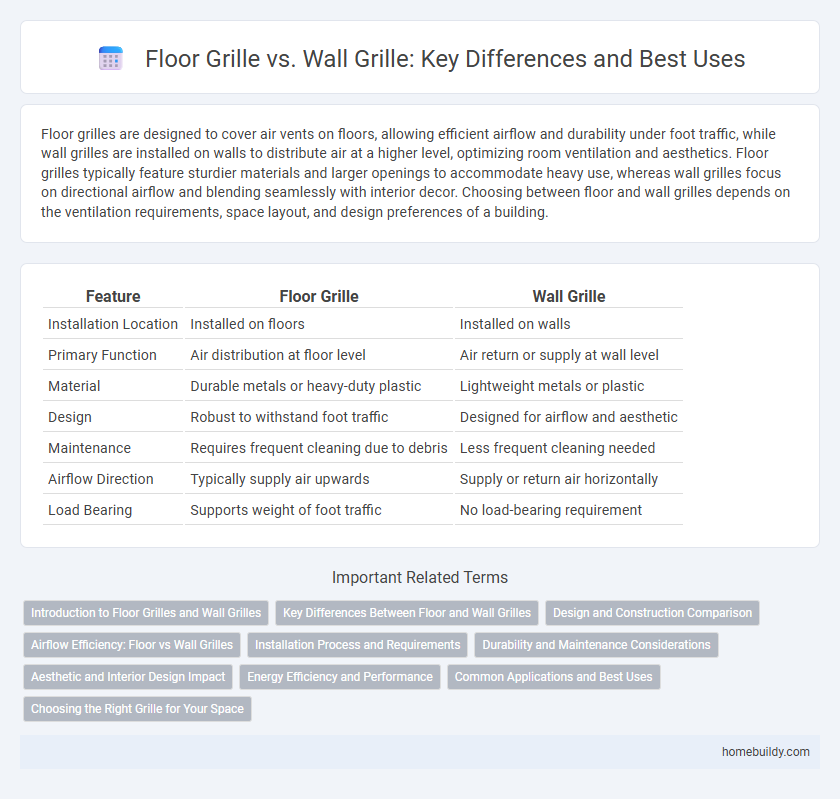Floor grilles are designed to cover air vents on floors, allowing efficient airflow and durability under foot traffic, while wall grilles are installed on walls to distribute air at a higher level, optimizing room ventilation and aesthetics. Floor grilles typically feature sturdier materials and larger openings to accommodate heavy use, whereas wall grilles focus on directional airflow and blending seamlessly with interior decor. Choosing between floor and wall grilles depends on the ventilation requirements, space layout, and design preferences of a building.
Table of Comparison
| Feature | Floor Grille | Wall Grille |
|---|---|---|
| Installation Location | Installed on floors | Installed on walls |
| Primary Function | Air distribution at floor level | Air return or supply at wall level |
| Material | Durable metals or heavy-duty plastic | Lightweight metals or plastic |
| Design | Robust to withstand foot traffic | Designed for airflow and aesthetic |
| Maintenance | Requires frequent cleaning due to debris | Less frequent cleaning needed |
| Airflow Direction | Typically supply air upwards | Supply or return air horizontally |
| Load Bearing | Supports weight of foot traffic | No load-bearing requirement |
Introduction to Floor Grilles and Wall Grilles
Floor grilles are designed to cover air vents installed in the floor, allowing for efficient air distribution while withstanding foot traffic and heavy loads. Wall grilles are mounted on walls to facilitate air flow from HVAC systems, often featuring adjustable louvers for directing airflow. Both serve critical roles in ventilation, with floor grilles optimized for durability and airflow near ground level, and wall grilles focused on aesthetic integration and directional air control at higher positions.
Key Differences Between Floor and Wall Grilles
Floor grilles are designed to handle heavier foot traffic and direct airflow horizontally, featuring durable materials and larger louvers to prevent debris buildup. Wall grilles focus on distributing air vertically, often incorporating adjustable dampers for precise airflow control and quieter operation. The key differences lie in their placement, structural robustness, and airflow direction, tailored to optimize ventilation efficiency in different building areas.
Design and Construction Comparison
Floor grilles are designed for heavy foot traffic and often constructed from durable materials like steel or aluminum with weighted frames to withstand pressure and allow efficient airflow. Wall grilles emphasize aesthetic integration with room decor, featuring lighter materials such as ABS plastic or thin metal, and customizable designs for different vent shapes and sizes. Both grille types incorporate adjustable louvers, but floor grilles prioritize robustness and slip resistance, while wall grilles focus on visual appeal and easy installation.
Airflow Efficiency: Floor vs Wall Grilles
Floor grilles generally offer superior airflow efficiency due to their placement allowing warm air to rise naturally, enhancing circulation within the room. Wall grilles, often positioned higher, may face obstacles that restrict airflow and reduce effectiveness. Selecting floor grilles can optimize HVAC performance by promoting better air distribution and energy savings.
Installation Process and Requirements
Floor grilles require a sturdy, level surface for installation to ensure proper airflow and support foot traffic, typically involving mounting into recessed floor openings with secure fasteners. Wall grilles necessitate cutting precise openings in drywall or masonry, often requiring structural reinforcement or framing to accommodate the grille securely while maintaining wall integrity. Both installation types demand accurate measurements and compatibility with HVAC system specifications to optimize ventilation efficiency.
Durability and Maintenance Considerations
Floor grilles are typically made from heavy-duty materials such as cast iron or steel to withstand foot traffic and resist wear, making them more durable than wall grilles, which often use lighter materials like aluminum or plastic. Maintenance for floor grilles involves regular cleaning to prevent debris buildup and occasional inspections for damage due to exposure to dirt and moisture. Wall grilles require less frequent maintenance but should be checked for dust accumulation and potential damage from impacts or environmental factors.
Aesthetic and Interior Design Impact
Floor grilles offer a sleek and unobtrusive ventilation solution that blends seamlessly with hardwood, tile, or carpeted flooring, creating a cohesive interior design while maximizing airflow efficiency. Wall grilles act as prominent design features or subtle accents depending on their material and finish, enhancing the room's vertical space and complementing contemporary or classic decor themes. Choosing between floor and wall grilles significantly influences the overall aesthetic by balancing functional ventilation needs with the desired visual impact in residential or commercial interiors.
Energy Efficiency and Performance
Floor grilles typically offer better airflow distribution and higher energy efficiency compared to wall grilles, as they allow warm air to rise naturally and circulate evenly throughout a space. Wall grilles can restrict airflow and create uneven temperature zones, reducing HVAC system performance. Selecting floor grilles enhances heating and cooling efficiency by optimizing air delivery and minimizing energy consumption.
Common Applications and Best Uses
Floor grilles are commonly installed in high-traffic areas like hallways, commercial spaces, and residential floors to facilitate efficient air distribution and prevent debris accumulation. Wall grilles are best suited for bedrooms, offices, and living rooms where discreet air supply or return is needed without obstructing floor space. Choosing between floor and wall grilles depends on airflow requirements, space constraints, and aesthetic preferences in HVAC systems.
Choosing the Right Grille for Your Space
Floor grilles are designed to provide efficient airflow while being durable enough to withstand foot traffic, making them ideal for heating and cooling systems embedded in flooring. Wall grilles offer better control of air distribution at higher levels and are often used for return air vents or supply air in rooms where floor installation is impractical. Choosing the right grille depends on factors such as the room's layout, airflow requirements, and maintenance accessibility to ensure optimal HVAC performance.
Floor Grille vs Wall Grille Infographic

 homebuildy.com
homebuildy.com